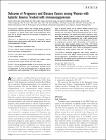| dc.contributor.author | MCCANN, SHAUN | |
| dc.date.accessioned | 2009-10-28T15:50:38Z | |
| dc.date.available | 2009-10-28T15:50:38Z | |
| dc.date.issued | 2002 | |
| dc.date.submitted | 2002 | en |
| dc.identifier.citation | Tichelli A, Socie G, Marsh J, Barge R, Frickhofen N, McCann S, Bacigalupo A, Hows J, Marin P, Nachbaur D, Symeonidis A, Passweg J, Schrezenmeier H. `Outcome of pregnancy and disease course among women with aplastic anemia treated with immunosuppression? in Annals of Internal Medicine, 151, (8), 2002, pp 164 - 172 | en |
| dc.identifier.other | Y | |
| dc.identifier.other | 62010 | |
| dc.identifier.other | Y | en |
| dc.identifier.uri | http://hdl.handle.net/2262/34398 | |
| dc.description | PUBLISHED | en |
| dc.description.abstract | Background: Aplastic anemia may develop during pregnancy and sometimes improves spontaneously after delivery. The effects of pregnancy on aplastic anemia after immunosuppressive treatment and of aplastic anemia on the outcome of pregnancy have not been described.
Objective: To determine the outcome of pregnancy and the disease course among women with aplastic anemia who received immunosuppressive therapy.
Design: Retrospective multicenter study.
Setting: Twelve centers participating in the European Group for Blood and Marrow Transplantation.
Patients: 36 women who received immunosuppressive therapy to treat aplastic anemia.
Measurements: Outcomes of pregnancy and aplastic anemia and blood counts before, during, and after delivery.
Results: The 36 pregnancies resulted in 34 live births (one set of twins), 2 elective abortions, and 1 spontaneous abortion. Of the 36 pregnancies, 22 were uncomplicated and 14 involved medical complications. Seven pregnancies (19%) were complicated by relapse of aplastic anemia, and 5 patients without relapse (14%) needed transfusions during delivery. After delivery, 3 of the 7 patients who had relapse recovered spontaneously and 3 recovered after retreatment. One patient who did not respond to treatment died of aplastic anemia. A woman with aplastic anemia and paroxysmal nocturnal hemoglobinuria had a fatal cerebral thrombosis after delivery. Women with uneventful pregnancies had better prepregnancy remission status (8 complete and 11 partial remissions) and a higher median platelet count (146 ? 109 cells/L) than did women with complicated pregnancies (2 complete remissions, 8 partial remissions, and 4 cases of paroxysmal nocturnal hemoglobinuria; median platelet count, 92 ? 109 cells/L).
Conclusions: Successful pregnancy with normal outcome is possible in women with aplastic anemia previously treated with immunosuppression. Complications appear to be more likely in patients with low platelet counts and paroxysmal nocturnal hemoglobinuria?associated aplastic anemia. | en |
| dc.format.extent | 164 | en |
| dc.format.extent | 172 | en |
| dc.format.extent | 221938 bytes | |
| dc.format.mimetype | application/pdf | |
| dc.language.iso | en | en |
| dc.publisher | American College of Physicians | en |
| dc.relation.ispartofseries | Annals of Internal Medicine | en |
| dc.relation.ispartofseries | 151 | en |
| dc.relation.ispartofseries | 8 | en |
| dc.rights | Y | en |
| dc.subject | Administrative Staff Authors | en |
| dc.title | Outcome of pregnancy and disease course among women with aplastic anemia treated with immunosuppression | en |
| dc.type | Journal Article | en |
| dc.type.supercollection | scholarly_publications | en |
| dc.type.supercollection | refereed_publications | en |
| dc.identifier.peoplefinderurl | http://people.tcd.ie/srmccann | |




